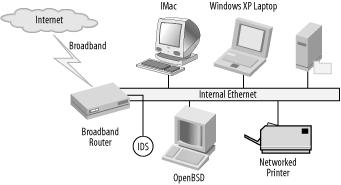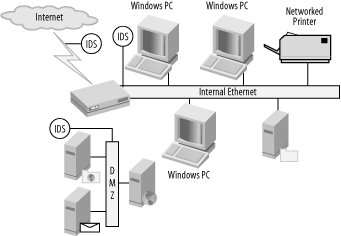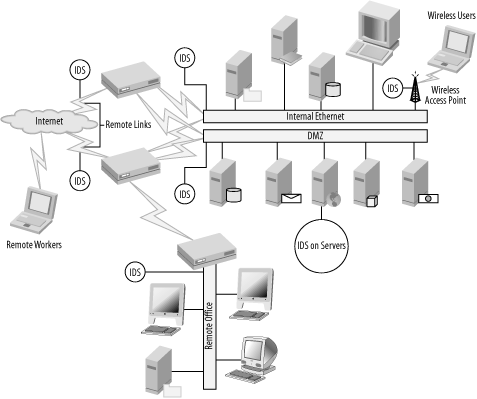Positioning Your IDS Sensors
Problem
Where do I position my IDS sensors?
Solution
Ideally you would position a number of IDS sensors in different locations, each of which covers a particular area of threat within your organization.
Some locations you should consider:
- Monitor any points of external access to the network (Internet, wireless, and VPN, for example).
- Ideally, you want to monitor both sides of any filtering tool.
- Monitor any DMZ area.
- Ideally, you want to monitor both sides if any machines are multihomed.
- Monitor any critical and/or vulnerable services (e.g., mail-, web-, and database- related services).
- Monitor any internal network connections between subnets.
- Monitor the internal network in general for internal problems.
Discussion
The following sections provide some case studies for you to consider.
Small business (or geek at home)
The scenario shown in Figure 1-12 has one point of entry. It doesn't contain many computers, and there are not a lot of complicated services running. The most traffic comes from file transfers, web access, and email. There is little to no risk of employee-related attack. The sensible way to monitor this network is to place the IDS to monitor inside the firewall at the point of access to the network. This will crop up potential issues that have passed through the firewall.
Figure 1-12. A home network

Medium-sized business
In a medium-sized network, there are several more places that are worth monitoring (see Figure 1-13). There should still be an IDS on the inner side of your firewall. In addition, you should monitor the demilitarized zone (DMZ) off your firewall. This area is the most at risk, as it is the most exposed. Often (and unadvisedly) machines in the DMZ have interfaces to the internal network. Any breach of these machines effectively circumvents any protection to the internal network provided by the firewall. This is where the external functions of the network usually lay, such as mail, the Web, FTP, and other servers that need to be accessible to the world at large. Within the network, as the size of the organization grows, it becomes prudent to monitor for inappropriate activity from within. Monitoring the use of key services, such as databases, and checking for abuse, will not only prevent an internal problem, but also back up the effectiveness of the IDS inside the firewall.
Figure 1-13. A medium-sized network

Larger organizations
As the size of the organization grows, so do the number of ways into and out of the network (see Figure 1-14). Large networks may have more servers running on the DMZ, multiple Internet connections for redundancy, wireless access points, and remote users with VPNsall adding up to a huge amount of traffic and potential problems. IDS should be strategically placed so you can monitor as many of these systems as possible, if not all of them. You should place the IDS snesors on significant points in the network such as servers, mainframes, and routers. All in all, if breaking something would result in a problem for your business, you should be looking at it.
Figure 1-14. Large network

You may consider all this to be quite extreme, but it isn't quite as bad as it seems. If you consider any medium to large organization, a significant number of the resources listed previously are in the same room. Linux-compatible gigabit Ethernet cards are available with up to six ports. Coupled with machines that have space for three or four PCI cards, you could have as many as 24 Ethernet ports (plus expansion modules can convert one PCI slot to 13 using an external enclosure). Using a single machine running multiple instances of Snort, you could do all of this easily in one room.
See Also
Caswell, Brian, et al. "Chapter 2.5: Using Snort on Your Network." In Snort 2.0 Intrusion Detection. Rockland, MA: Syngress, 2003.
Capturing and Viewing Packets |
Installing Snort from Source on Unix
- Installing Snort from Source on Unix
- Installing Snort Binaries on Linux
- Installing Snort on Solaris
- Installing Snort on Windows
- Uninstalling Snort from Windows
- Installing Snort on Mac OS X
- Uninstalling Snort from Linux
- Upgrading Snort on Linux
- Monitoring Multiple Network Interfaces
- Invisibly Tapping a Hub
- Invisibly Sniffing Between Two Network Points
- Invisibly Sniffing 100 MB Ethernet
- Sniffing Gigabit Ethernet
- Tapping a Wireless Network
- Positioning Your IDS Sensors
- Capturing and Viewing Packets
- Logging Packets That Snort Captures
- Running Snort to Detect Intrusions
- Reading a Saved Capture File
- Running Snort as a Linux Daemon
- Running Snort as a Windows Service
- Capturing Without Putting the Interface into Promiscuous Mode
- Reloading Snort Settings
- Debugging Snort Rules
- Building a Distributed IDS (Plain Text)
- Building a Distributed IDS (Encrypted)
Logging to a File Quickly
- Logging to a File Quickly
- Logging Only Alerts
- Logging to a CSV File
- Logging to a Specific File
- Logging to Multiple Locations
- Logging in Binary
- Viewing Traffic While Logging
- Logging Application Data
- Logging to the Windows Event Viewer
- Logging Alerts to a Database
- Installing and Configuring MySQL
- Configuring MySQL for Snort
- Using PostgreSQL with Snort and ACID
- Logging in PCAP Format (TCPDump)
- Logging to Email
- Logging to a Pager or Cell Phone
- Optimizing Logging
- Reading Unified Logged Data
- Generating Real-Time Alerts
- Ignoring Some Alerts
- Logging to System Logfiles
- Fast Logging
- Logging to a Unix Socket
- Not Logging
- Prioritizing Alerts
- Capturing Traffic from a Specific TCP Session
- Killing a Specific Session
How to Build Rules
- How to Build Rules
- Keeping the Rules Up to Date
- Basic Rules You Shouldnt Leave Home Without
- Dynamic Rules
- Detecting Binary Content
- Detecting Malware
- Detecting Viruses
- Detecting IM
- Detecting P2P
- Detecting IDS Evasion
- Countermeasures from Rules
- Testing Rules
- Optimizing Rules
- Blocking Attacks in Real Time
- Suppressing Rules
- Thresholding Alerts
- Excluding from Logging
- Carrying Out Statistical Analysis
Detecting Stateless Attacks and Stream Reassembly
- Detecting Stateless Attacks and Stream Reassembly
- Detecting Fragmentation Attacks and Fragment Reassembly with Frag2
- Detecting and Normalizing HTTP Traffic
- Decoding Application Traffic
- Detecting Port Scans and Talkative Hosts
- Getting Performance Metrics
- Experimental Preprocessors
- Writing Your Own Preprocessor
Managing Snort Sensors
- Managing Snort Sensors
- Installing and Configuring IDScenter
- Installing and Configuring SnortCenter
- Installing and Configuring Snortsnarf
- Running Snortsnarf Automatically
- Installing and Configuring ACID
- Securing ACID
- Installing and Configuring Swatch
- Installing and Configuring Barnyard
- Administering Snort with IDS Policy Manager
- Integrating Snort with Webmin
- Administering Snort with HenWen
- Newbies Playing with Snort Using EagleX
Generating Statistical Output from Snort Logs
- Generating Statistical Output from Snort Logs
- Generating Statistical Output from Snort Databases
- Performing Real-Time Data Analysis
- Generating Text-Based Log Analysis
- Creating HTML Log Analysis Output
- Tools for Testing Signatures
- Analyzing and Graphing Logs
- Analyzing Sniffed (Pcap) Traffic
- Writing Output Plug-ins
Monitoring Network Performance
- Monitoring Network Performance
- Logging Application Traffic
- Recognizing HTTP Traffic on Unusual Ports
- Creating a Reactive IDS
- Monitoring a Network Using Policy-Based IDS
- Port Knocking
- Obfuscating IP Addresses
- Passive OS Fingerprinting
- Working with Honeypots and Honeynets
- Performing Forensics Using Snort
- Snort and Investigations
- Snort as Legal Evidence in the U.S.
- Snort as Evidence in the U.K.
- Snort as a Virus Detection Tool
- Staying Legal
Index
EAN: 2147483647
Pages: 167
